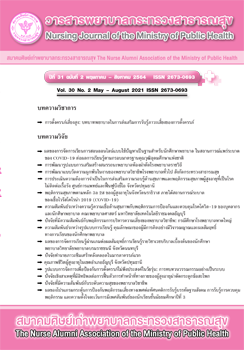The Relationship among Knowledge, Health Beliefs and COVID-19 Prevention and Control Behavior of Staff and Nursing Students, Faculty of Nursing Rajamangala University of Technology Thanyaburi
Main Article Content
Abstract
This research aimed to study the levels of knowledge, health beliefs, and prevention and control behavior related to COVID-19 among faculties, staff, and nursing students and to examine the relationship between those variables during Coronavirus Disease 2019 (COVID-19) Pandemic. The samples of 125 participants were selected by stratified random sampling from faculties, staff, and nursing students. The data were collected online using research tools. The research instruments included demographic, knowledge, health beliefs, and prevention and control behavior related to COVID-19 questionnaires. These tools were approved for the content validity by 3 experts. The reliabilities of knowledge and COVID-19 prevention and control behavior questionaires were tested using Kuder-Richardson -20, and they were .73 and .79. The Cronbach’s alpha coefficient was used to examine the reliability of health belief questionnaire, and it was .84. Data were analyzed using descriptive statistics and Pearson’s correlation coefficient.The results showed that the average score of knowledge was at the highest level ( =14.88, SD=.14). Health belief score was high (
=122.33, SD=12.76) and prevention and control behavior was in the highest level (
=11.92, SD=.30). There was no statically significant relationship between knowledge, health beliefs, and prevention and control behavior among faculties, staff, and nursing students (r=-.001, p-value=.995; r=.042, p-value=.641, respectively). To promote the COVID-19 prevention and control behavior of faculties, staff, and students, the university should continuously support essential material and equipments to protect and prevent the disease.
Article Details
บทความและรายงานวิจัยในวารสารพยาบาลกระทรวงสาธารณสุข เป็นความคิดเห็นของ ผู้เขียน มิใช่ของคณะผู้จัดทำ และมิใช่ความรับผิดชอบของสมาคมศิษย์เก่าพยาบาลกระทรวงสาธารณสุข ซึ่งสามารถนำไปอ้างอิงได้
References
during_Covid-19/links/5ea85618a6fdcc705094ba50/Non-communicable-disease-management-in-
vulnerable-patients-during-Covid-19.pdf
2. Constituent Committee. Order of the Prime Minister’s office No.76/2563 on establishment of the Coronavirus disease situation management center (COVID-19) [Internet].2020 [cited 2021 Mar 25]; Available from:
http://www.nsc.go.th/wp-content/uploads/2020/05/CV19-01.pdf
3. Catton H. ICN calls for data on healthcare worker infection rates and deaths [Internet].2020 [cited 2020 November 25]; Available from: https://www.icn.ch/news/icn-calls-data-healthcare-worker-infection-rates-and-deaths
4. Visanuyothin T. Number of Thai healthcare workers infected by COVID-19 rises by 7 to 87 on April 12 [Internet].2020 [cited 2021 March 25]; Available from: https://hrdo.org/en/number-of-thai-health care-workers-infected-by-covid-19-rises-by-7-to-87-on-April-12/
5. Petchpoom C. Health Belief Model: HBM. Health behaviors, concepts, theories, and applications. edition1. Phitsanulok: Naresuan University Press;2017.(in Thai).
6. Swadeshi R, Hashemi M, Khanjan N. The impact of educational intervention based on the health belief model on observing standard precautions among emergency center nurses in Sirjan. Health Educ Res [Internet]. 2018[cited 14-06-2021];33(4):327-35. Available from: https://pubmed.ncbi.nlm.nih.gov/30007332/
7. Kim MJ, Yun SJ. Convergence study on the factors influencing nursing ‘ attitudes toward standard precautions: focusing on the Health Belief Model. JKCS [Internet]. 2018 [cited 2021 June 25];9(6):77-88 Available from:https://doi.org/10.15207/JKCS.2018.9.6.077
8. Suphanthat S. Behavior and change. (units 1-7). In Kitti Wattanakul (editor). Tutorial series of health Chia.: department of health sciences. Edition 16. Nonthaburi: Sukhothai Thammathirat Open University;1999.(in Thai).
9. Sukpoon U, Kingmala C, Pangsuk P,Yuenyao T, Wangman W. Effectiveness of health literacy and health behavior development program for working people. J. of Health Science [Internet]. 2020[cited 2021 June 14]; 29(3):419-28. Available from: https://thaidj.org/index.php/JHS/article/view/9207/8357
10. Bloom BS. Taxonomy of educational objectives, the classification of educational goals handbook. edition1. New York: McKay;1956.
11. Yothongyot M, Sawatdisan P. Determination of sample size for research purpose. [Internet]. 2020 [cited 2020 March 29]; Available from: http://www.fsh.mi.th/km/wp-content/uploads/2014/04/resch.pdf
12. University of Technology Thanyaburi. Faculty of Nursing. New graduate nursing curriculum 2018. Prathumthani: the university;2017.(in Thai).
13. Thai Nursing Council. Infection control nurse’ roles in infection prevention and control for COVID-19 within healthcare setting. [Internet]. 2020 [cited 2020 November 11]; Available from: https://www.tnmc.or.th/images/userfiles/files/Covid-Update01042020.pdf
14. Li L, Chungquing L, Zunyu W, Guan J, Jia M, Yan Z. HIV-Related avoidance and universal precaution in medical settings: opportunities to intervene.2010. Health Serv Res [Internet].2011 [cited 2020 June 30]; 46(2):617-31.Available from: https://onlinelibrary.wiley.com/doi/abs/10.1111/j.1475-6773.2010.01195.x
15. Glomjai T, Kaewjiboon J, Chachvarat T. Knowledge and behavior of people regarding self-care prevention from novel Coronavirus 2019 (COVID-19). J of Nursing Public Health and Education 2020;21(2):29-39.
16. Waehayi H. Severity perception and preventive behavior on the Coronavirus disease-2019 among youth at Sateng-Nok subdistrict, Muang district, Yala province. AJCPH 2020;6(4):158-68.
17. Tuicharoen J, Wongprakhob N, Munsrake K, Nimkratoke T. Management of the COVID-19 in primary health care settings. J. of Health Science Boromarajachonani Colleage of Nursing Sunpasithiprasong 2021; 4(3):1-20.(in Thai).
18. Thai PBS NEWS. Thailand ranked number 1 in recovery country-best in dealing with COVID-19 in the world [Internet].2020 [cited 2020 Oct 10]; Available from https://news.thaipbs.or.th/content/295007
19. Vasittivong P. Health Belief Model and prevention HIV infection behavior by universal precaution of nurses in Trad hospital, Thailand. Medical J.1996;3:273-83.
20. Phawangkharat S, Artchanacuk S, Namsu P. A study of COVID-19 situation’s surveillance prevention and control in communities towards village health volunteers. [Internet]. 2021 [cited 2021 Feb 20]; Available from: http://phc.moph.go.th/www_hss/data_center/dyn_mod/(Full_paper_edit)_A_Study_
of_COVID-19_Surveillance,_Prevention_and_Control_in_Communities_(1)_dec_jan_21.pdf

